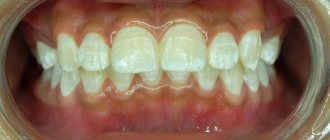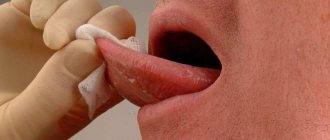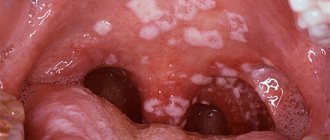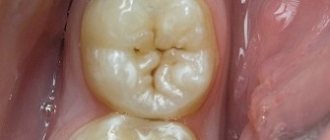- Published by: Laima Jansons
The appearance of any pigmentation on the lips should not be ignored . If a blue dot appears on the lip, even more so. Because this always indicates the presence of malfunctions in the body.
Interesting! Doctors distinguish between two main types of spots - youthful and senile. Both cases have their own characteristics and causes. Before starting treatment for a defect, you should understand what caused it to appear.
How is it formed
Every person from birth has a genetically determined skin color - the so-called permanent pigment.
When exposed to external and internal factors, an additional one is produced, which can be either a temporary physiological phenomenon (natural tanning) or a pathological one, difficult to remove even with special lasers (lentigo, vitiligo, etc.). The formation mechanism itself occurs in the epidermal layer. Here are located keratinocytes - epidermal cells. Their life cycle is up to 60 days, so they are constantly updated. To protect young and vulnerable cellular structures from sun exposure, melanocytes exist. They belong to the nervous system and are called upon to produce melanin, which absorbs ultraviolet radiation.
If the body is healthy, there is no overdose of solar radiation, melanocytes will produce a sufficient amount of protection. However, if there are failures, the “protectors” begin to be distributed unevenly, which leads to the formation of hyperpigmented areas.
Causes of hyperpigmentation
An increase in melanin production can be associated both with physiological changes occurring in the body and as a result of pathologies. The most well-known factors influencing the occurrence of stains are:
- endocrine diseases;
- hormonal changes during pregnancy or menopause;
- diseases of the gastrointestinal tract and adrenal glands;
- metabolic disorder;
- vitamin deficiency or hypervitaminosis;
- helminthic infestations;
- severe intoxication of the body;
- trauma or inflammatory processes;
- prolonged exposure to the sun;
- taking medications - antibiotics of the tetracycline group, gentamicins, erythromycins, as well as some NSAIDs, salicylic acid, antidepressants, diuretics, sleeping pills and sedatives, antihistamines, St. John's wort extract, etc.;
- heredity.
Changes can also appear due to prolonged stress. Since melanocytes belong to the nervous system, any fluctuations and unstable conditions lead to serious pigmentation disorders.
Localization of spots
They can have different sizes, both with clear contours and blurry ones, merge together or not grow at all. Depending on the differential diagnosis and the type of hypermelanosis, they can be located both in certain areas and without specific boundaries, covering absolutely any area of the body.
On the face
One of the most common sites of localization of many hyperpigmentations. This is due to the fact that the skin here is thin enough so that negative factors can attack them faster. Among the common phenomena are freckles, which can decorate the face all year round and also appear and disappear after exposure to the sun. They are also localized over the entire surface or located pointwise in the area of the cheeks, eyes, and forehead.
Anti-age drugs
Bb Laboratories – Delicate oil for deep cleansing
Laennec – solution for injection
Bb Laboratories – Two-phase serum concentrate
Two-phase placental serum concentrate
On the body
Namely on the arms, shoulders, chest, back, groin area. For each individual disease, there are areas where pigment accumulation is observed. For example, senile hyperpigmentation is typically located on the hands, forearms, and upper back.
Causes of blackheads on the upper lips. Predisposing factors
Initially, you need to find out what black dots on the lips are and the mechanism of their appearance. The entire surface of the human skin is covered with sebaceous glands. These glands produce sebaceous secretions. When there is an excess of sebum, the skin becomes oily. With this type of skin, enlarged pores are most often observed, so blackheads around the lips most often occur in those with oily and combination skin.
The skin secretions mix with dust particles, which clog the pores. Under the influence of ultraviolet radiation, the contents of the pores acquire a dark color, a black head is formed, which is called a blackhead or blackhead.
Blackheads appear infrequently over the upper lip. More often, this problem appears on other parts of the face (nose, forehead, chin). Dark spots appear under the influence of certain predisposing factors, which include:
- Dysfunctions in the hormonal environment. In case of disturbances in the production of hormonal substances (mainly progesterone and estrogen), the speed of the sebaceous glands increases. This is accompanied by increased sweating, increased growth of body hair, changes in the timbre of the voice, and the skin of the face becomes covered with an oily sheen. With an excess of sebaceous secretion, pores become clogged not only on the face, but also along the contour of the lips.
- Lack of proper hygiene. This reason is very common. It is more common among women who do not wash off cosmetics at night. Such careless attitude towards the skin provokes severe irritation, a decrease in the natural protective barrier of the epidermal layer, and the appearance of dark acne. Remove your makeup and your skin will thank you. This point also includes professional activity in a dusty environment and frequent skin contact with foreign substances.
- A skin care product that is not suitable for a particular case can cause a blackhead near the lip contour. The black spot most often occurs when an oil-based product (coconut oil) is used. Oil clogs the pores, preventing the skin from breathing, as a result of which it becomes dirty and pathogenic microorganisms develop on it. Decorative cosmetics – lipsticks and lip gloss – can also have an oil base. Before getting rid of dark spots, you should avoid using oil-based makeup products.
Types and symptoms of age spots
Let's consider the most characteristic signs of hypermelanosis, as well as control methods that are relevant for each specific type of pathology.
Freckles
The most common type of melanin accumulation. They are mainly located on the face, in the cheek area. In advanced cases, they can completely cover the entire surface of the skin with small distances between the spots. And also have a round or oval shape, small diameter, clear contours.
Genetic predisposition plays a major role, so freckles can appear in childhood. People with red and blond hair are most susceptible to them. This is due to the need for high melanin production to protect the skin.
Freckles can be easily distinguished from other types of spots by the complete disappearance of pigmentation in cold weather, and the appearance of a whole scattering on the face with the arrival of warmth. Therefore, to combat them, creams with maximum sun filters are used throughout the year, as well as lightening cosmetics.
Melasma
Spots without clear boundaries and endings, varying in shade from bronze to dark brown. They have the ability to stretch, grow, and merge with each other into huge pigmented areas that occupy a large surface of the body. The main provoking factor is considered to be hormonal disorders caused by menopause, pregnancy, and the use of oral contraceptives. Treatments include peeling methods and procedures that promote cell renewal. When the root causes are eliminated, the stains quickly disappear.
Melasma
The second name is melanosis. It can be acquired or hereditary, manifests itself in the form of an accumulation of melanin with uneven but clear boundaries and localization in open areas of the body. May occur as a result of Addison's disease, hemochromatosis, due to sensitivity to ultraviolet radiation, anthracene or acridine substances, diseases of the pituitary gland, ovaries, adrenal glands, syphilis, tuberculosis, malaria, treatment with hormones. Pigmentation is accompanied by redness, itching, peeling, and roughening of the skin.
To prevent progress, sunscreens are used, drug therapy is prescribed with steroid groups, retinoids, hydroacids, and vitamins B (1.6) and C are additionally used.
Becker's nevus
A characteristic defect in men, it is much less common in women. The first manifestations can be as early as 10 years of age. It is a hyperpigmented area protruding above the surface of the skin, on which dark long hairs grow. It occurs both as a result of genetic factors and can appear after sun exposure, changes in hormonal levels, in particular androgens. The location most often is the upper back and chest; it is not often found on the legs, groin, or head. It has a warty surface on which acne or comedones can be seen. Does not respond well to any cosmetic procedures or medications. An argon laser is used to minimize the aesthetic defect.
Secondary
Occurs at the site of mechanical damage. They can be either deep cuts, scratches, or acne, comedones, ulcers and other superficial causes that trigger the inflammatory process in the skin cells. There is an excess of melanin, resulting in staining. They are localized where the damage was and go away after the area returns to normal and the inflammation disappears. To speed up the lightening process, you can use special lightening creams or cosmetic procedures aimed at renewing the epidermal layer.
Age
As we age, the negative effects of ultraviolet radiation lead to increased melanin production in certain areas of the body. These are usually open areas that have been exposed to a lot of sunlight during their lifetime. With age, spots appear with a diameter of 1 to 5 cm, which are darker in color than the entire surface of the skin.
Berlocc's dermatitis
Refers to contact types of immune response to irritants. Usually due to contact with perfumes, colognes, and deodorants. It is located where the skin came into contact with the substance. Symptoms may include not only a change in the color of the dermal layer, but also itching, peeling, and swelling. It disappears quickly, just stop using perfume and in a few days everything will return to normal.
Chloasma
Large spots can merge into one large skin defect. They do not have a clear contour or boundaries and can grow and increase in size throughout life. Among the provoking factors are pregnancy and lactation, menopause, changes in hormonal levels due to diseases, stress, taking oral contraceptives, steroids, the use of hormone-containing ointments and some cosmetics.
Reasons for the formation of age spots
Often, the appearance of age spots is influenced by: exposure to ultraviolet radiation on the skin, disruption of internal organs, hereditary pigmentation, skin trauma, hormonal and age-related changes. Let's take a closer look at each of them.
Exposure to ultraviolet rays
In most cases, the main reason is exposure to ultraviolet radiation. The sun is the main reason for their appearance. Even if this problem is genetically programmed, ultraviolet rays will be the trigger that will reveal these defects faster.
Ultraviolet radiation, affecting the skin, causes protective reactions against damage, which provoke the activity of melanocytes (they produce pigment). Melanocytes quickly produce melanin. Moreover, it spreads unevenly, especially in places of severe ultraviolet damage. As a result, spots appear on the protruding parts of the face (on the nose and cheekbones), which begin to darken with age.
Disruption of internal organs
There are cases that spots appear from a disease and this is not a cosmetic defect. In this case, it is impossible to get rid of it if the underlying pathology is not eliminated.
The most common diseases of internal organs with skin hyperpigmentation:
- During hypertension, spots appear around the eyes
- Pigmentation appears in the mouth due to the liver
- In the nose area for heart pathologies
- On the chin due to endocrine disorders
- Pigment spots in men and women indicate circulatory disorders due to diabetes mellitus or arteriosclerosis
- Pigment spots in the groin area (genital diseases and fungal infections)
It is impossible to make a diagnosis based only on detecting in which part of the body the pigmentation appeared. If you have dermatological problems, contact your doctor immediately and get examined.
Hereditary pigmentation
In the case of genetic pigmentation, traces of freckles or moles often form not due to defective melanocytes, but in places where they are naturally enriched. Ultraviolet light activates cells and ephelides appear. Each person can have a similar genetic makeup, but it most often occurs in very fair-skinned people (blonds and redheads).
Skin injuries
The area of injury may develop post-traumatic discoloration, scratches, or pimples. This is part of the body's defense response, which activates the production of melanin. This darkening will take a long time to correct. Additionally, the use of bleach in this situation is prohibited. They increase inflammation and therefore increase the immune response. The dimming will only get worse.
Hormonal changes
The skin reacts violently to any changes in hormone levels. In women, this level is less stable due to the characteristics of natural processes in the body. The sensitivity of the epidermis to external irritants increases due to an imbalance in the production of progesterone and esterogen.
Appears in the process:
- Breastfeeding
- Climax
- Puberty
- Carrying a child
- Menses
At the end of pregnancy, the load on a woman’s internal organs increases, which also negatively affects the condition of the skin. So-called liver spots appear on the body.
Age-related changes
Pigment spots occur in older people. Their formation is mainly associated with a slowdown in metabolic processes in the body. Older people have endocrine disorders. In women, menopause is a major risk factor. The second reason is thinning of the skin. Because of this, melanocytes practically rise from the deep layers.
Side effects of medications
Some medications can cause your face to dry out after a sunburn. This occurs if the drug has a photosensitizing effect, that is, it significantly increases sensitivity to ultraviolet radiation.
Side effects may occur from taking the following types of medications:
- Medicines for hypertension and heart failure (clothiazide)
- Medicines for rheumatoid arthritis (azulfidine)
- Antidepressants (melipramine)
- Oral contraceptives
Also, burns may occur at the site of marks on the body, followed by hyperpigmentation.
What causes pigment spots to appear on the face after sunbathing?
Most manifestations of hyperpigmentation occur after the negative effects of ultraviolet rays. Among those that immediately appear are freckles, various melasma and chloasma. There are also those that have a cumulative effect, for example, lentigo.
Also, if during the summer vacation there were inflammatory processes in open areas of the body, most likely after they heal, a change in shade can be clearly observed.
Prolonged exposure to the hot sun with the presence of existing tumors and increased pigmentation can be fraught with the degeneration of harmless spots into aggressive cancer - melanoma. Therefore, you should limit your tanning time and use special cosmetics for protection.
How to remove pigmentation on the face at home using cosmetics
If the spots are not intense and do not occupy large areas, you can make them lighter yourself. Pharmaceutical products and skincare products are suitable for this:
- Hydroquinone, lavender oil, hydrogen peroxide, and resorcinol have an exfoliating and keratolytic effect.
- Weak fruit acids, which can be used at home, work well to whiten stains. This is citric, ascorbic, and lactic acid of low concentration. These products are also suitable for preparing for salon chemical peels.
- Lightening cosmetic compositions marked Anti-Pigment. Creams, lotions and serums containing azelaine, kojic acid, vitamin C.
Any product can be used only after testing for possible allergies. If the body accepts the composition calmly, without a negative reaction, you can begin the procedures according to the instructions for the drug.
Age spots and peeling
Melanin accumulation occurs in the upper layers of the epidermis. In order to remove unaesthetic problems, products that stimulate the renewal of the dermis are used. The most effective peelings are: chemical, mechanical, laser. They promote the regeneration of epidermal cells, forcing keratinocytes to produce new ones as quickly as possible, which will not have a large accumulation of coloring pigment. When eliminating the root causes of hyperpigmentation, there is a chance that you will forget about various spots for a long time.
Laser removal of age spots
Laser removal of age spots is considered one of the newest and most effective methods. The principle of laser operation is approximately the same, regardless of skin formation. The pigment spot is irradiated with a light beam of a certain length. The laser beam then damages and destroys the melanin in the cells, creating a lighter spot.
Based on the depth of melanin appearance in the skin, these points are divided into:
- epidermal (superficial) dermal (located deep in the skin)
- epidermal-skin spots (mixed)
Indications
The indication for laser removal is the presence of the following formations on the face and other parts of the body:
- spots that appear after sunburn
- epidermal moles (nevi)
- the appearance of pigmentation in wound healing areas
- acne marks
- seborrheic keratosis (numerous superficial papillomatous formations)
- angiomas (cancer) and red spots
- chloasma (excessive pigmentation caused by changes in hormone levels or diseases of the genitourinary system)
- freckles (small pigment spots on the skin ranging from light yellow to light brown)
- Lentil age spots (changes in skin color caused by melanin accumulation)
- pigmented scars (except keloids)
It should be noted that currently there are several methods for correcting skin imperfections: chemical peeling, mesotherapy, cryopilling, etc. However, they act superficially, only partially removing pigments and promoting cell regeneration. The clinic specialist will definitely come to the conclusion that the laser removal procedure for pigment spots is necessary when the methods described above are not enough.
This cosmetic procedure is a skin intervention. Although the complexity of the procedure and subsequent recovery period does not require hospitalization, it is classified as a surgical procedure. In this regard, there are several contraindications.
Advantages
The justification for the cost of this procedure is explained by the following advantages:
- The light works specifically, removing only the necessary pigmented areas
- The duration of the procedure is short
- Skin disinfection occurs when the laser destroys bacteria
- Simultaneous cauterization of the wound, stopping bleeding and preventing the development of infection
- A rejuvenating effect is achieved due to the fact that the skin becomes firm and elastic
- Non-contact (the specialist’s hands do not touch the treated area)
- No pain after laser treatment, therefore, there is no need for painkillers
- There is no risk of further inflammation, so the recovery period will not be long in coming
- The risk of other side effects is minimal
The use of anesthetics is possible if the area being lasered is large or if the pigment is deep enough in the skin.
Preparation for the procedure
The effectiveness of the procedure depends on the preparatory stage, which begins with a visit to a specialist. The dermatologist will select the necessary procedure for removing age spots, taking into account the client’s health profile and skin characteristics. The number of sessions to achieve the desired result is also determined, which can be adjusted during the procedure.
At this point, it is clear how much the planned change will cost in total. It should be noted that planned gradual removal of pigmentation in this area can take a long time, since a repeat session is possible after three months.
Until the prescribed procedure is completed, you can follow these tips:
- do not sunbathe or visit a solarium
- do not thoroughly cleanse the skin; do not drink alcohol and tobacco
Pigmentation can be removed using different types of lasers:
- fractional
- alexandrite
- neodymium
- diode
The presented lasers have a targeted effect and act only on the pigmented area. Healthy skin is not affected.
Fractional laser is preferred because its light beam vaporizes melanin through microscopic damage. One beam per square centimeter is capable of distinguishing up to 1,100 areas, penetrating to a depth of 1.5 millimeters.
The neodymium laser is different in that it heats melanin and oxyhemoglobin. This means that it can also be used to remove vascular formations. It is quite powerful and penetrates deeply into the skin.
The list does not include a rarely used type of laser - ruby. Laser removal of pigment spots using a ruby laser is rare because it does not differentiate cells with normal and high melanin content well enough. Used very rarely and on very fair skin. Do not use on dark skin to avoid exposing unwanted areas.
How is the laser pigment spot removal procedure performed?
The laser operation consists of many short flashes of light, which may be accompanied by loud noise. The laser beam is dangerous for the organs of vision, so the specialist and the customer wear glasses during the procedure.
The procedure is gradual and is performed according to the following scheme:
- The skin is cleansed (makeup removal, antiseptic treatment).
- A product is applied to the area to ensure deep penetration of the rays into the skin.
- The specialist applies the laser to the selected area.
- The surface of the skin is treated with an antiseptic.
- A sterile bandage or bandage is applied to the area of skin to allow for further healing.
Redness and swelling may appear immediately after the procedure, which lasts about a day. The wound itself becomes covered with a crust, which disappears after 5 days. You should not touch it or remove it yourself, as in this case a scar may form. Once the scab completely melts, it makes room for new, healthy cells containing normal levels of melanin.
Sometimes the specialist performing the procedure suggests using a product, usually panthenol. The use of decorative cosmetics in this area is prohibited.
Causeless manifestations
It happens that people try to protect their skin, use special sunscreens, but hyperpigmented areas still appear. It's like it happens for no apparent reason. However, for melanocytes to malfunction, even a small but prolonged stress or temporary hormonal imbalance is enough.
It is also worth noting the cumulative negative effect of ultraviolet radiation, which can manifest itself over the years on areas of the body that received sunburn in early childhood. Therefore, only at first glance it seems that hypermelanosis arose without provoking factors. In fact, he has hidden reasons.
Black dots on lips. What to do with a black dot on the lip?
on the lip or several around the mouth - the problem is not common, but very annoying. Such a cosmetic defect is difficult to ignore, however, getting rid of it can be difficult. After all, mechanical removal is contraindicated due to the risk of skin scarring, and without combating the cause, the problem may soon return.
Why do acne appear on the lips?
It is not advisable to squeeze out blackheads on your lips yourself.
This pathology is nothing more than a banal contamination of the pores. This often happens to those with oily skin, which is characterized by disturbances in the functioning of the sebaceous glands.
An excess of secretion leads to the expansion of pores, as a result of which, without observing special hygiene rules, these openings become clogged with a mixture of grease and dust from the environment.
However, such disorders are unusual for the skin of the lips, which is why there is almost panic in this area.
The following factors are prerequisites for clogged pores:
- Hormonal disbalance. If a woman’s body has a disruption in the production of progesterone and estrogen, the secretion of the sebaceous glands increases, along with it there is increased sweating, a change in the timbre of the voice and the rate of growth of hair on the body (and their structure becomes different). This problem is quite serious and can cause not only black spots near the lips, but also lead to more significant disorders inside the body.
- Lack of hygiene. Working in a dusty environment, frequent contact with foreign substances on the skin, careless attitude to removing makeup - all this leads to clogged pores, comedones and various rashes. For example, due to this lifestyle, white pimples may appear in the corners of the lips, inflammatory and allergic reactions. In addition, the overall tone of the skin can decrease, which leads to premature aging.
- Wrong selection of skincare products. The formation of blackheads and acne is often caused by cosmetics based on oils and synthetic components. The entry of such substances into the pores causes contamination and blocks the epidermis's ability to breathe. This environment is favorable for the development of pathogenic microflora, so it is better to avoid the use of artificial cosmetics.
Liver pigment spots
Deterioration in the functionality of internal organs can also lead to the formation of aesthetic defects. The liver plays the role of a filter, retaining and processing all dangerous substances, and then removing them from the body. In cases where she fails to cope with her duties, slow but sure intoxication occurs, which is manifested not only by internal, but also by external pathologies.
Metabolic processes in tissues are disrupted, including the normal distribution of melanin; it accumulates in certain areas. Most often it appears on the face. The contours of such spots are not uniform, they do not have a clear boundary. The color can also vary from light to dark brown.
Which method of removing age spots should I choose?
Modern cosmetology offers a wide selection of products and techniques for restoring a uniform and radiant complexion. How to remove pigment spots should be decided by the doctor after a preliminary examination of the patient. Self-administration of aggressive drugs can cause the development of difficult-to-treat side diseases that aggravate chronic diseases.
At the moment, the most effective method is laser removal of age spots. The main reasons for this choice are a less painful procedure, a quick and predictable result, the absence of foreign bodies in the skin tissue (unlike injection methods), and quick rehabilitation (thanks to a gentle regimen).
If you can’t decide on a method for removing age spots, start with laser.
Lentigo
The phenomenon is popularly known as “senile ripples.” Appears in older people in areas of the body that have been exposed to intense ultraviolet rays throughout their lives. The pigment usually appears on the arms from the hands to the top of the shoulders, upper back, décolleté, and face. It is distinguished by its small size, different diameters and chaotic arrangement of spots.
The first manifestations can be noticed after 40 years; they noticeably age the appearance, so many people at this stage turn to cosmetologists to eliminate the defect. During menopause, hormonal changes lead to an increase in the amount of pigment. Chemical, mechanical and laser peels are used for treatment. Cosmetics and whitening creams will not cope with the problem.
Subcutaneous blackheads. What are comedones
A comedon is the name given to a “plug” of sebum and dead epidermal cells in a hair follicle or pore. Externally, the rashes look like the well-known “black dots” on the skin or bumps. Comedones are a type of acne, but without signs of inflammation. In some places, however, in the area of their accumulation, isolated inflamed elements (red pimples) may be observed. This is the next stage of comedonal development if a bacterial infection occurs.
The frequency of diagnosis of comedones is approximately the same in both men and women.
The distribution of comedonal eruptions varies from mild cases (with small areas affected) to more severe cases when large areas of the body are covered. The rash may develop on the face, back, neck and chest. Most often, comedones appear on the forehead, chin or nose.
Blackheads, or open comedones, can be considered as the initial stage of pimple development
Like most types of acne, comedones are especially common during adolescence. Although adults are not immune from them, especially those with oily and combination skin types. There is often a family tendency to such rashes. For example, if parents had comedones, then children have an increased risk of this dermatological problem.
The cause of comedones in children is unknown. Typically, the presence of acne in them is not associated with excessive levels of testosterone or other androgenic (male sex) hormones, and children with such a rash do not differ in appearance from their peers.
In children, the occurrence of comedones is not associated with hormonal imbalance
Comedones can appear in newborns on the second or third day of life. This happens due to a “hormonal crisis,” which is expressed in the accumulation of a large amount of maternal sex hormones in the child’s body.
Varieties
Comedones can be open or closed, and their type determines the nature of the rash. Open comedones (blackheads) are what we more often call acne. They occur when a plug of sebum blocks the duct of the hair follicle. The upper part of the plugging mass is exposed to air (oxidizes) and therefore becomes brown or black.
Open comedones - black or dark brown acne - are clearly visible on the face
Closed comedones (whiteheads) occur when the ducts of the follicles are completely blocked, and the plug of sebum and desquamated epidermal cells is not exposed to air. The cork does not turn black; instead, bumps or bumps on the skin are visually visible. They are not inflamed, but the skin does not look perfectly smooth. In addition, in the future there is a risk of inflammation of the rash elements.
Closed comedones are small flesh-colored bumps
According to size, acne elements are divided into:
- microcomedones - very small, may not be visible to the naked eye;
- macrocomedones - elements with a diameter of more than 2–3 mm;
- Giant comedones are a type of cyst that has a clear, acne-like opening in the skin.
Giant comedon is a type of epidermal cyst.
There is another type of comedones - actinic, or solar. They develop as a result of photodamage and age-related changes in the skin. That is why this type is observed in older people, and the lesions are located mainly on the face.
Solarium - is it harmful?
It is also a mistake to think that sun tanning is harmful, and nothing will happen in specialized salons in a few minutes. On the beach, the skin gets a lot of heat, but this happens gradually. In the booths, a loading dose of ultraviolet radiation is given in a few minutes, which is difficult to obtain outdoors even in a whole day.
People with a fair skin type, with the presence of moles and nevi, freckles, existing aesthetic defects in the form of increased melanin production, need to get rid of the habit of visiting a solarium. The consequences can be expressed both in the progression of unsightly changes in the epidermal layer, and in their degeneration into malignant neoplasms.
Causes of blue lips
In their practice, doctors call blue lips cyanotic. If blue lips are not directly related to hypothermia, this is definitely a good reason to see a doctor. Many patients turn to a specialist not to determine the cause of blue lips, but because it is aesthetically unsightly. It is quite difficult to explain to the vast majority that blue edges of the lips are a symptom that must be properly examined in order to protect the patient himself.
Often, upon hearing what causes blue color around the lips, patients begin to panic, assume serious diagnoses, etc. This should not be done ahead of time, because this symptom may be physiological in nature.
It is very important to understand that the blue rim around the lips in an adult and a child most often has a different origin. In a child, blue lips along with a cough and difficulty breathing may indicate a serious infectious disease - true or false croup.
Reynod's disease, although a fairly rare disease, also manifests itself as cyanotic lips. With this disease, the vessels are very fragile and when exposed to various factors, for example, very low ambient temperature, or excessive levels of stress, they lead to the vessels bursting.
Blue lips can be a sign of a chronic or acute disease, or they can be temporary and physiological in nature.
The most common reason why lips turn blue is insufficient oxygen. Oxygen starvation occurs as a result of the toxic effects of gases, smoking, working in harmful conditions, etc.
In a person with a reduced number of red blood cells and a low level of the oxygen carrier protein hemoglobin, this may also be the reason why the lips turn blue. With anemia, blueness of the lips is combined with pallor of the skin, general weakness, and drowsiness. Anemia can be accompanied not only by diseases, but also by physiological conditions, such as pregnancy. Blue lips are also observed after massive blood loss (gastrointestinal bleeding, as a result of surgical interventions, etc.).
If both the skin and lips have a blue tint, then it is necessary first of all to exclude cardiovascular pathology. It is necessary to pay attention to the pulse rate, its rhythm and filling, monitor exercise tolerance, whether shortness of breath has appeared, etc. The combination of these symptoms may indicate bronchial asthma, coronary heart disease, pulmonary embolism, etc. These conditions are life-threatening and may require resuscitation measures.
Diagnostics
To accurately determine the type of hypermelanosis, as well as to identify effective means of control, you need to contact a dermatologist. At the initial visit, the doctor will collect the patient's medical history to determine the most likely internal and external factors that will indicate a certain type of disorder. He will examine the skin and also prescribe a number of tests:
- AOK and OAM;
- blood biochemistry;
- Wood's lamp tests;
- scraping;
- biopsy.
If a malignant neoplasm or fungal infection is suspected, referrals will be given for the last two procedures on the list. As a result, the specialist will be able to accurately determine the type of illness and prescribe therapeutic or cosmetic procedures.
Anti-age drugs
Bb Laboratories – Hyaluron-elastin-collagen extract
Laennec – solution for injection
Curacen Essence (20 fl x 2 ml)
Two-phase placental serum concentrate
How to fight
Among the modern and effective methods of struggle, it is worth highlighting:
- cosmetic preparations;
- laser peeling;
- phototherapy.
Depending on the variety, medications may be prescribed to address the underlying causes. However, to remove an aesthetic defect, it will be necessary to wait for the cell surface to renew itself, or to help it renew itself faster with the help of additional deep peeling and cosmetic photorejuvenation procedures.
Cosmetic preparations
Among the popular drugs that give noticeable results in the fight against hyperpigmentation are placental products with a high content of natural peptides, amino acids and hyaluronic acid, as well as vitamins, micro- and macroelements. Injection product Curacen (Curasen) and non-injection drug Curacen Essence (Curasen Essence) are the ideal choice of cosmetologists for triple action: brightening, moisturizing and eliminating wrinkles. You can also use specialized cosmetics from the Laennec Skincare brand - LNC. This line offers to transform the skin at the cellular level, eliminating and preventing hyperpigmentation.
Now you know about the main causes of pigmentation, as well as what causes the appearance of age spots on the face, and you can easily answer the question - what to do when pigments have already appeared. Dermatologists recommend not only limiting time spent on the beach and using sunscreen in summer, but also year-round use of skin protection from the negative effects of ultraviolet radiation. It is this that becomes the main catalyst, and in combination with internal disorders of the body can lead to serious changes in the epidermal layer.
Removing pigment spots
The most effective and fastest ways to eliminate age spots are offered by beauty salons. The most popular procedures in this area are laser removal of age spots, phototherapy, cryotherapy, chemical and ultrasound peeling and mesotherapy.
Phototherapy
Phototherapy is a procedure for removing age spots of any size, color and texture. The method is one of the most effective in combating discoloration from various sources. Broadband pulsed light acts on the necessary target cells: oxyhemoglobin and melanin.
Unlike laser treatments and chemical peels, all other components of the skin are not damaged. Removal by phototherapy is indicated for the following types of spots:
- Melasma
- Chloasma
- Lentigo
- Keratomas
- Post-traumatic hyperpigmentation (for example, caused by chemical peels in sunny seasons)
- Freckles (partially)
The phototherapy procedure can get rid of stagnant age spots on the face after acne, infiltrates, wounds and cuts. Sometimes one procedure is enough to significantly lighten age spots. If the spots are too large and too colorful, the doctor may prescribe a course of three to five sessions.
Long-term phototherapy regimens are also relevant for those who pursue the following goals:
- Skin thickening and tightening
- Narrowing and smoothing of skin relief
- Elimination of vascular forms
- Refreshing complexion
Phototherapy is not currently the best solution for removing age spots.
Cryotherapy
Helps completely eliminate unwanted pigmentation, warts and various formations. Cryotherapy or freezing can only be performed by a qualified specialist with medical education.
There may be some mild discomfort during the procedure , but no anesthesia is required as the sensations are tolerable. If the pain does not go away after the procedure, you can use painkillers. Very rarely, the procedure for removing age spots with nitrogen leads to swelling of the lower extremities and the appearance of large blisters. This is a short-term phenomenon that quickly disappears.
Chemical peeling
Used to renew skin over large areas. This procedure is based on the effect on the upper layers of the epithelium using special chemicals. Chemical peeling is one of the most effective products designed specifically for removing stains:
- eliminates pigmentation
- removes scars and small scars
- brightens the skin and eliminates freckles
The disadvantages of chemical peeling include the risk of complications , including redness of the skin, allergic reactions and the occurrence of dermatological diseases. This should not be done during pregnancy and breastfeeding, in the presence of non-healing rashes, skin ulcers and in people with epilepsy.
Ultrasonic peeling
A unique procedure that allows you to restore youth and purity of your skin after the first session. This is done using mineral water or ultrasound. Both options are completely painless. The main advantage is that one session is enough to remove small pigments. If necessary, the process can be repeated after 2 weeks. Not recommended for neuralgia, tumors, pregnancy and the postoperative period.
Mesotherapy
The mesotherapy technique was developed in the middle of the last century by French doctors. Features of the procedure:
- Treatment involves introducing various biologically active substances into the body through injections.
- The choice of suitable substances is decided by the cosmetologist.
- They are based on vitamin complexes, amino acids and active substances for certain molecules.
- The downside is that the first effects do not appear immediately.
To completely eliminate skin pigmentation, up to 15 sessions every 7-10 days will be required. Contraindications: individual intolerance to the selected injection drugs, pregnancy, tendency to epilepsy and allergies.











